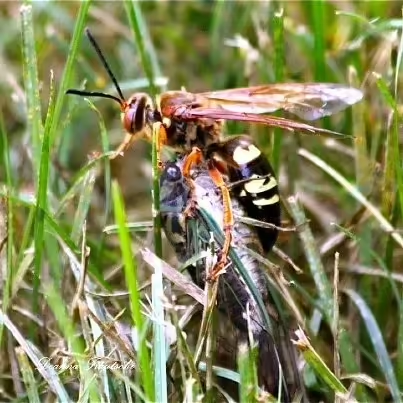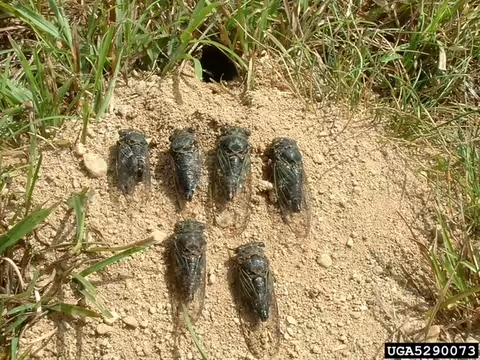The summer nights of Illinois stir the senses with the illuminating performance of lightning bug and the concerts of the cicada. The annual cicadas have begun to sing their song, and along with them comes the emergence of their natural predator, the cicada killer wasp.
Cicadas are imperative in the life cycle of the cicada killer wasp, which despite their threatening size, are not a concern to humans.
Annual Cicadas
Annual cicadas, also known as "dog day" cicadas emerge in July and are starting to be heard in backyards across the Midwest. They are green and black with silvery wings. Hatched from eggs laid in the branches of trees, cicada nymphs fall to the ground and burrow into the soil. The nymphs feed on the sap found in tree and shrub roots for two to five years. When they emerge, they build chimneys, climb up the tree, and leave as flying adults.
The singing of these annual cicadas, or deafening chorus depending on your tolerance level, alerts predators of their presence. Cicada killer wasps come out of hibernation to feast on the annual treat, but Ken Johnson, Extension horticulture educator, says it is mostly temperature that causes cicada killer wasps to emerge not the cicada's sound.
Cicada Killer Wasps
Cicada killers are a native wasp species, and, as their name implies, hunt only cicadas and other solitary insects. Despite their menacing name, cicada killers are usually non-aggressive toward humans.
Cicada killer wasps can sting humans if threatened, but it takes work to provoke or aggravate them. Females cicada killers can sting, but only when handled or disturbed. Males cannot sting, but may investigate an intruder in its territory to see if it is another male.
Identification
- Cicada killers are black with yellow markings on the thorax and abdomen
- Can grow up to 1.5 inches
- They have large, rust-colored eyes and orangish-red wings and legs.
Cicada killers dig underground tunnels after they mate. Females prefer dry, well-drained bare ground to build their nests. They then leave in search of cicadas to feed their future larvae, stopping along the way to drink nectar and water.
A female wasp will sting a cicada, injecting venom to paralyze it before carrying it back to the nest, where it is placed in a cell. The cicada killer lays eggs on the cicada before sealing the cell. The female may place up to three cicadas for one egg.
The wasp larvae hatch in a few days and begin to feed on the cicada throughout winter and spring. About a month before they leave the cell, the larvae spin a cocoon to pupate before emerging.
Preventing wasp nests
For gardeners concerned about safety of children or pets, Illinois Extension suggests planting ground covers and grass to prevent bare spots, adding mulch, and using irrigation to deter wasps from nesting.
ABOUT THE AUTHOR: Kelly Allsup is a Horticulture Educator for University of Illinois Extension serving Livingston, McLean and Woodford Counties. She meets the educational needs of her community, including local chapters of Master Gardener and Master Naturalist volunteers, through expertise in home horticulture and entomology. Her passion for ecologically-friendly gardening and all things plants makes her a dynamic speaker on topics that range from beneficial insects, growing vegetables and fruits, to urban trees.

